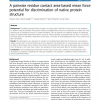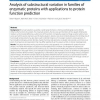BMCBI
2010
14 years 17 days ago
2010
Background: An algorithm is presented to compute a multiple structure alignment for a set of proteins and to generate a consensus (pseudo) protein which captures common substructu...
BMCBI
2010
14 years 17 days ago
2010
Background: Considering energy function to detect a correct protein fold from incorrect ones is very important for protein structure prediction and protein folding. Knowledge-base...
BMCBI
2010
14 years 17 days ago
2010
Background: Structural variations caused by a wide range of physico-chemical and biological sources directly influence the function of a protein. For enzymatic proteins, the struc...
BMCBI
2010
14 years 17 days ago
2010
Background: Partitioning of a protein into structural components, known as domains, is an important initial step in protein classification and for functional and evolutionary stud...
BMCBI
2010
14 years 17 days ago
2010
Background: We present here the recent update of AMS algorithm for identification of post-translational modification (PTM) sites in proteins based only on sequence information, us...
BMCBI
2010
14 years 17 days ago
2010
Background: Large datasets of protein interactions provide a rich resource for the discovery of Short Linear Motifs (SLiMs) that recur in unrelated proteins. However, existing met...
BMCBI
2010
14 years 17 days ago
2010
Background: The knowledge about proteins with specific interaction capacity to the protein partners is very important for the modeling of cell signaling networks. However, the exp...
BMCBI
2010
14 years 17 days ago
2010
Background: With the current technological advances in high-throughput biology, the necessity to develop tools that help to analyse the massive amount of data being generated is e...
BMCBI
2010
14 years 17 days ago
2010
Background: It is well known that most of the binding free energy of protein interaction is contributed by a few key hot spot residues. These residues are crucial for understandin...
BMCBI
2010
2010
Orientation-dependent backbone-only residue pair scoring functions for fixed backbone protein design
14 years 17 days ago
Background: Empirical scoring functions have proven useful in protein structure modeling. Most such scoring functions depend on protein side chain conformations. However, backbone...




